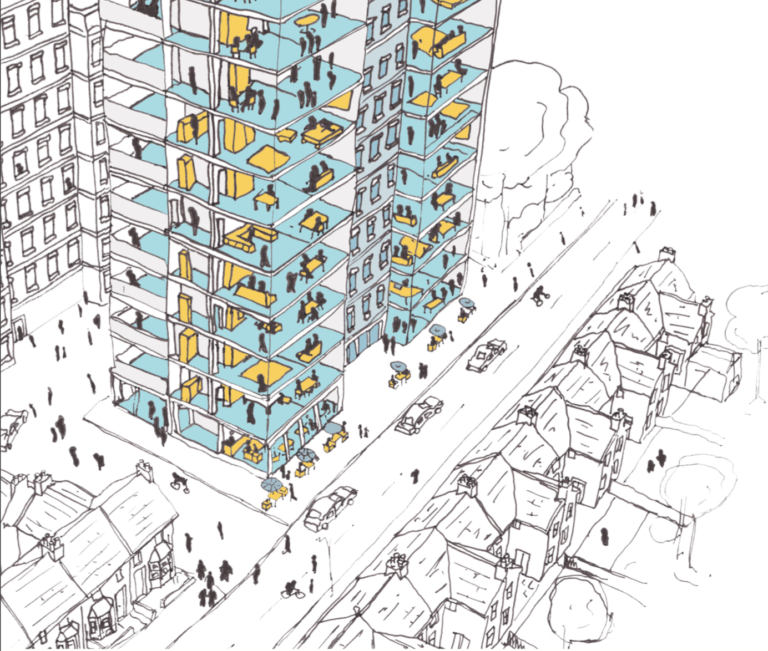High Density Housing
Developments of residential areas with a higher population density than typical are known as high-density housing. For example, High-rise apartments are deemed as high density, mostly when compared to single-family homes or condos.
This type of housing is usually proposed in areas where the real estate prices are too high, and there is not much land available for construction. As a matter of Fact, many unused warehouses and older establishments are often adapted to be reused and converted to high-rise residential complexes.

Fig 1: Battersea Power Station Housing, shot by Nishita Valli, January 2024.
What are the main advantages of High-Density housing?
- Reduced infrastructure costs on maintenance.
- Lesser traffic raises property values.
- Slower urban deterioration
- Attracts new businesses and employment opportunities.
- Lesser damage on the environment. [1]
Environmental benefits of High-Density housing:
- Saves Essential Ecosystems: Population increase limited inside the city’s established borders, due to the high density of housing. Adaptive reuse is a great alternative to creating new land for construction. [2]
- Increasing Energy Efficiency: Structures are tall. Hence, as the warm air rises higher floors use less energy. The use of better insulation materials, helps in preserving heating and cooling.[2]
- Lastly, ease of achieving a self-sufficient neighbourhood: A region with higher density can offer more services at a closer distance. However, all essential services are available nearby, people rely on less 0oon transportation and access everything in walking distance.[2]

Fig 2: LSE London. (2018). [6]
Example of High density Housing: Dockley Apartments / Studio Woodroffe Papa
The development integrates, social, private, and shared housing units on a site that was previously industrial. It is surrounded by housing estates and a railway bridge. Therefore, As a part of a larger rehabilitation of railway arches along Southwarks’s “Lowline”. A range of stores, restaurants, and cafes, found at ground level. [3]

Fig 3: www.dockley-apartments.co.uk. (n.d.). Dockley Photos | Gallery | Dockley Apartments. [5]
In conclusion, high-density buildings typically found in urban regions. While, low-density housing found in suburban and rural areas.
They offer the advantages of attracting businesses and employment, boosting property value. Moreover, they help in reducing traffic.
Overall, they encourages sustainability by promoting a lower dependence on transportation. Lowering overall energy usage, and building up rather than clearing structures.
References:
[1]. Kistler, K. (2022). High Density Housing: What Is It & How Does It Affect Multifamily? [online] Video Intercom System for Apartment Buildings | ButterflyMX. Available at: https://butterflymx.com/blog/high-density-housing/.
[2]. Anon, (2022). What Are the Environmental Benefits of High-Density Housing? [online] Available at: https://www.unsustainablemagazine.com/benefits-of-high-density-housing/#:~:text=High%2Ddensity%20housing%20pulls%20away.
[3]. ArchDaily. (2022). Dockley Apartments / Studio Woodroffe Papa. [online] Available at: https://www.archdaily.com/994044/dockley-apartments-studio-woodroffe-papa?ad_source=search&ad_medium=projects_tab.
[4] Kistler, K. (2022). High Density Housing: What Is It & How Does It Affect Multifamily? [online] Video Intercom System for Apartment Buildings | ButterflyMX. Available at: https://butterflymx.com/blog/high-density-housing/.
[5] www.dockley-apartments.co.uk. (n.d.). Dockley Photos | Gallery | Dockley Apartments. [online] Available at: https://www.dockley-apartments.co.uk/gallery/ [Accessed 31 Mar. 2024].
[6] LSE London. (2018). More homes in less space: living in high-density housing in London. [online] Available at: https://blogs.lse.ac.uk/lselondon/more-homes-in-less-space-living-in-high-density-housing-in-london/.


